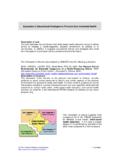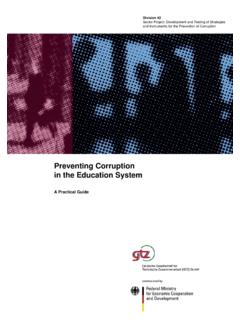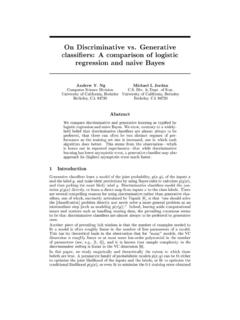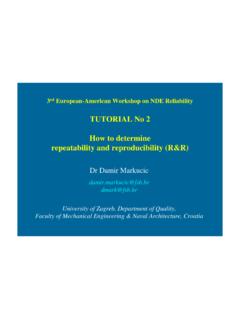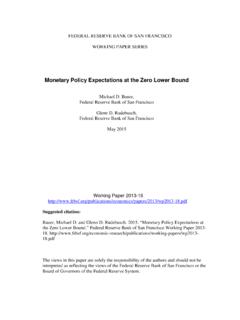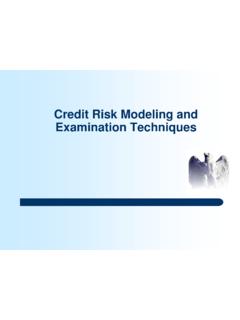Transcription of Glossary - INEE Toolkit
1 Bryman: Social Research Methods, 4th edition Oxford University Press, 2012. All rights reserved. Glossary Abduction A form of reasoning with strong ties with induction that grounds social scientific accounts of social worlds in the perspectives and meanings of participants in those social worlds. Action research An approach in which the action researcher and a client collaborate in the diagnosis of a problem and in the development of a solution based on the diagnosis. Ad libitum sampling A sampling approach in structured observation whereby whatever is happening at the moment that observation is due to occur is recorded. Adjacency pair The tendency for certain kinds of activity in talk to be characterized by linked phases. Analytic induction An approach to the analysis of qualitative data in which the researcher seeks universal explanations of phenomena by pursuing the collection of data until no cases that are inconsistent with a hypothetical explanation (deviant or negative cases) of a phenomenon are found.
2 Arithmetic mean Also known simply as the mean, this is the everyday average namely, the total of a distribution of values divided by the number of values. Asynchronous online interview or focus group Online interviews may be asynchronous or synchronous. In the case of the former, the transactions between participants are not in real time, so that there may be long spaces of time between interviewers questions and participants replies, and, in the case of focus groups, between participants contributions to the discussion. Attached email questionnaire survey A survey in which respondents are sent a questionnaire, which is received as an attachment by email. Compare with embedded email survey. Behaviour sampling A sampling approach in structured observation whereby an entire group is watched and the observer records who was involved in a particular kind of behaviour. Bryman: Social Research Methods, 4th edition Oxford University Press, 2012.
3 All rights reserved. Biographical method Also often referred to as the life history method, this method emphasizes the inner experience of individuals and its connections with changing events and phases throughout the life course. The method usually entails life history interviews and the use of personal documents as data. Bivariate analysis The examination of the relationship between two variables, as in contingency tables or correlation. CAQDAS An abbreviation of Computer-Assisted (or -Aided) Qualitative Data Analysis. Case study A research design that entails the detailed and intensive analysis of a single case. The term is sometimes extended to include the study of just two or three cases for comparative purposes. Category In grounded theory, a category occupies a space between a researcher s initial theoretical refl ections on and understanding of his or her data and a concept, which is viewed as a higher level of abstraction.
4 Thus, a category has an intermediate position in terms of abstraction between coding and a theory. Causality A concern with establishing causal connections between variables, rather than mere relationships between them. Cell The point in a table, such as a contingency table, where the rows and columns intersect. Census The enumeration of an entire population. Unlike a sample, which comprises a count of some units in a population, a census relates to all units in a population. Thus, if a postal questionnaire is mailed to every person in a town or to all members of a profession, the research should be characterized as a census. Chi-square test Chi-square is a test of statistical significance, which is typically employed to establish how confident we can be that the fi ndings displayed in a contingency table can be generalized from a probability sample to a population. Bryman: Social Research Methods, 4th edition Oxford University Press, 2012.
5 All rights reserved. Closed question A question employed in an interview schedule or self-completion questionnaire that presents the respondent with a set of possible answers to choose from. Also called fixed-choice question and pre-coded question. Cluster sample A sampling procedure in which at an initial stage the researcher samples areas ( clusters) and then samples units from these clusters, usually using a probability sampling method. Code, coding In quantitative research, codes act as tags that are placed on data about people or other units of analysis. The aim is to assign the data relating to each variable to groups, each of which is considered to be a category of the variable in question. Numbers are then assigned to each category to allow the information to be processed by the computer. In qualitative research, coding is the process whereby data are broken down into component parts, which are given names. Coding frame A listing of the codes used in relation to the analysis of data.
6 In relation to answers to a structured interview schedule or questionnaire, the coding frame will delineate the categories used in connection with each question. It is particularly crucial in relation to the coding of open questions. With closed questions, the coding frame is essentially incorporated into the pre-given answers, hence the frequent use of the term pre-coded question to describe such questions. Coding manual In content analysis, this is the statement of instructions to coders that outlines all the possible categories for each dimension being coded. Coding schedule In content analysis, this is the form onto which all the data relating to an item being coded will be entered. Comparative design A research design that entails the comparison of two or more cases in order to illuminate existing theory or generate theoretical insights as a result of contrasting findings uncovered through the comparison. Concept A name given to a grouping of phenomena that organizes observations and ideas by virtue of their possessing common features.
7 In grounded theory, a concept is a key building block in the construction of a theory. Bryman: Social Research Methods, 4th edition Oxford University Press, 2012. All rights reserved. Concurrent validity One of the main approaches to establishing measurement validity. It entails relating a measure to a criterion on which cases ( people) are known to differ and that is relevant to the concept in question. Confounding variable A variable that is related to each of two variables the result of which is to produce the appearance of a relationship between the two variables. Such a relationship is a spurious relationship. Connotation A term used in semiotics to refer to the principal and most manifest meaning of a sign. Compare with denotation. Constant An attribute in terms of which cases do not differ. Compare with variable. Constant comparison A central tool of grounded theory that entails constantly comparing new data with existing data, concepts, and categories.
8 It also entails comparing categories with each other and categories with concepts. Constructionism, constructionist An ontological position (often also referred to as constructivism) that asserts that social phenomena and their meanings are continually being accomplished by social actors. It is antithetical to objectivism. Content analysis An approach to the analysis of documents and texts that seeks to quantify content in terms of predetermined categories and in a systematic and replicable manner. The term is sometimes used in connection with qualitative research as well see qualitative content analysis. Contingency table A table, comprising rows and columns, that shows the relationship between two variables. Usually, at least one of the variables is a nominal variable. Each cell in the table shows the frequency of occurrence of that intersection of categories of each of the two variables and usually a percentage. Continuous recording A procedure in structured observation whereby observation occurs for extended periods so that the frequency and duration of certain types of behaviour can be carefully recorded.
9 Bryman: Social Research Methods, 4th edition Oxford University Press, 2012. All rights reserved. Control group Sometimes used in experiements, which involves a research design that rules out alternative causal explanations of findings deriving from it ( possesses internal validity) by having at least (a) an experimental group, which is exposed to a treatment, and a control group, which is not. Convenience sample A sample that is selected because of its availability to the researcher. It is a form of non-probability sample. Conversation analysis The fine-grained analysis of talk as it occurs in interaction in naturally occurring situations. The talk is recorded and transcribed so that the detailed analyses can be carried out. The analysis is concerned with uncovering the underlying structures of talk in interaction and as such with the achievement of order through interaction. Conversation analysis is grounded in ethnomethodology.
10 Correlation An approach to the analysis of relationships between interval/ratio variables and/or ordinal variables that seeks to assess the strength and direction of the relationship between the variables concerned. Pearson s r and Spearman s rho are both methods for assessing the level of correlation between variables. Covert research A term frequently used in connection with ethnographic research in which the researcher does not reveal his or her true identity. Such research violates the ethical principle of informed consent. Cram r s V A method for assessing the strength of the relationship between two variables, at least one of which must have more than two categories. Critical discourse analysis A form of discourse analysis that emphasizes the role of language as a power resource that is related to ideology and socio-cultural change. It draws in particular on the theories and approaches of Foucault. Critical realism A realist epistemology that asserts that the study of the social world should be concerned with the identifi cation of the structures that generate that world.
